Sea buckthorn is called the prickly garden shrub, which by August-September is literally covered with fruits. The glossy yellow berries of wild sea buckthorn have a tart sour taste, and numerous shoots of the bush itself “drown out” the plants growing next to it. But this applies only to its wild varieties, in our article we will talk about how to plant and grow the cultivated sea buckthorn, which also has a decorative appearance in the fall.
Landing rules
A unique feature of sea buckthorn is that all its cultivars have female and male trees. If you plant them together, then they will pollinate each other and produce an excellent crop. Up to 10 kg of crop can be removed from a single female tree. Before you start planting should:
- Choose a suitable seedling.
- To decide on the place of landing.
- Prepare the ground.
- Choose the best time to land.
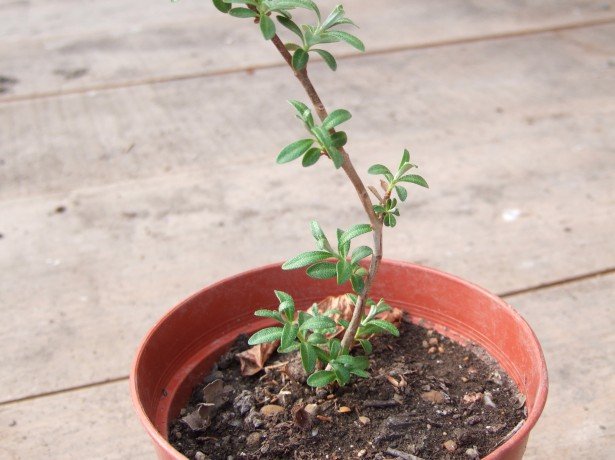
Up to 10 kg of crop can be removed from a single female tree.
The cultivated plant sea buckthorn, planting and caring for which do not present any particular difficulty, has medium or large berries of a rich yellow or orange color, there are also varieties with red, sour-sweet fruits. The most popular varieties of this fruit shrub, which are recommended to be planted in our latitudes, are:
- Amateur
- Panteleevskaya.
- Favorite.
- Chuy.
- Vorobyevskaya.
When buying seedlings, preference should be given to those selling nurseries that have all permits. This will guarantee that you will have exactly the variety that you choose.
Sea buckthorn, as well as garden cranberries , grows well near houses, along roads, and also on the edge of the infield. It is imperative that this shrub grow far from garden plots. The fact is that the sea buckthorn has long, weakly branching roots, which can extend tens of meters from its trunk to the sides, being shallow, directly below the surface of the earth. Injury at least one root process significantly weakens the tree and can even lead to his death. That is why the soil around the bush is not recommended to dig. In addition, wounded spade root shoots lead to abundant wild shoots around, which can be difficult to eradicate.
Video about the secrets and subtleties of growing It is important to remember that sea buckthorn loves light very much, so the place chosen for its landing should not be in the shadow.
This fruit is planted in early spring, introducing sand, humus and phosphorus-potassium fertilizer into a hole prepared in advance for a seedling. It does not hurt the ashes, if the planting is made in acidic soil. When planting several bushes the minimum distance between them should be 2.5 meters.
Order of care
This fertilizer, which was poured into the hole prepared for planting the sapling, will last for 2 years. During this time, it is recommended to keep the soil around it under a black steam, and then you can plant parsley next to the tree, spinach and other garden greens.
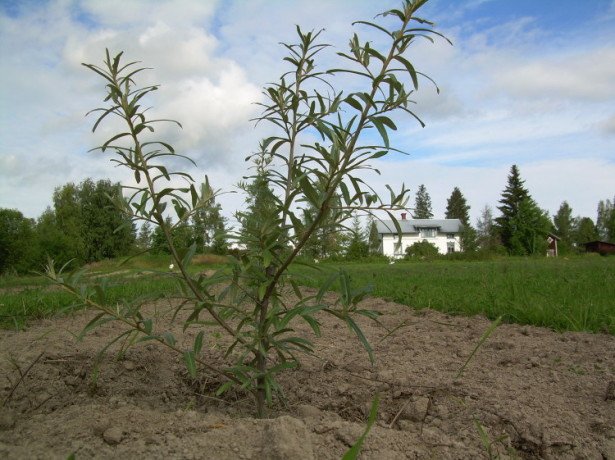
Sea buckthorn can be planted with grass
And yet, as an option, the place under the sea buckthorn can be sown with lawn grass and not cut it when mowing. This will be an excellent natural fertilizer, creating sea buckthorn favorable conditions for growth and development. Work the soil under the sea buckthorn should be no deeper than 7 cm.
Due to the fact that its roots are directly below the soil surface, it is necessary to carefully control its watering, avoiding overflow. This is especially important in June - when buds are formed on the tree. It is also important not to allow the formation of a crust on the earth, when it appears the soil will need to be loosened.
As for feeding, it should be done 1 time in 3 years. It should consist of both organic and mineral fertilizers, supplemented with nitrogen. Pustered manure can be poured around the trunk and around the trunk circle every year - this will help to strengthen the roots.
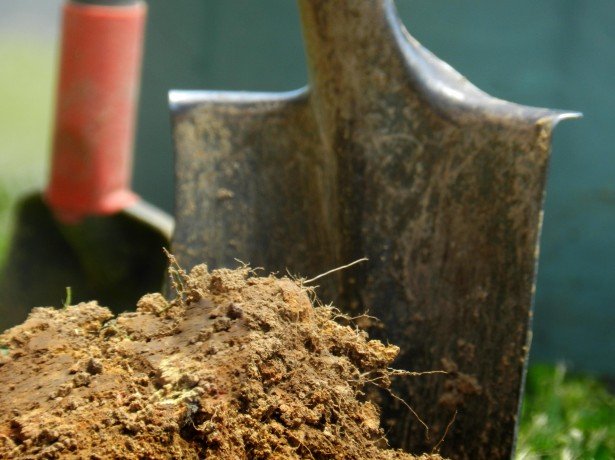
It is important to prevent the formation of crusts on earth.
In the spring without fail should be pruned dry branches. This is necessary to give the tree a neat appearance and prevent pests from accumulating under them. The same applies to the young, wild shoots around the sea buckthorn. It also needs to be promptly removed.
Diseases and pests
Sea buckthorn, especially its young trees, is extremely susceptible to diseases and pests that can catch up with it at any moment. It can hurt:
- Endomycosis.
- Black leg.
- Scab.
- Fusarium.
- Brown rot, etc.
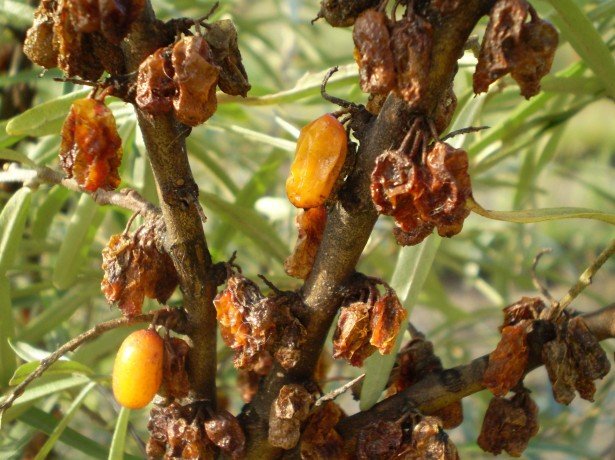
Sea buckthorn, especially its young trees, is extremely susceptible to diseases and pests.
Especially often affects shrub endomikoz. This fungal disease leads to the fact that sea-buckthorn berries lose their aroma and elasticity - they easily choke in their hands when picked, and the following year, if left untreated, the tree stops producing fruits almost completely. To rid the plant of this fungal scourge, copper oxychloride and Bordeaux liquid are used. You need to process the tree twice - at the end of flowering and in July.
As for pests, among those who can seriously hit this bush, it can be noted:
- Sea buckthorn moth.
- Sea buckthorn fly.
- Sea buckthorn aphids.
The first two pests must be fought with chlorophos, and decoctions of potatoes, tobacco leaves, onion peels and soap solutions will be effective against aphids.
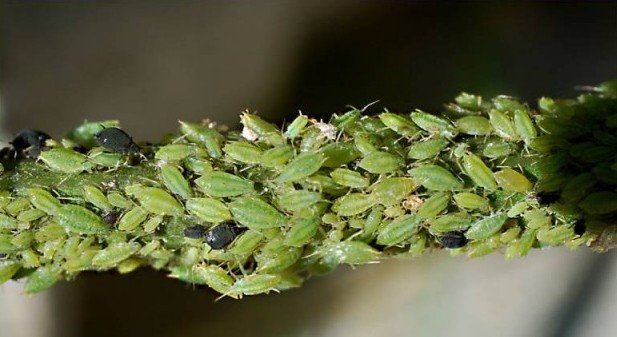
Potatoes, tobacco leaves, onion peels and soap solutions will be effective against aphids.
Breeding
Sea buckthorn breeding, as well as raspberry breeding in the spring, most often occurs by cuttings. But for these purposes can be used:
- Shoots.
- Layering.
- Seeds.
- Vaccinations.
To obtain the mother plant is used exclusively for growth. This is done in the following way - for two periods - spring and summer, the earth is curled around it and kept wet for the speedy growth of its roots, after which it is cut off from the parent root and landed in the prepared hole.
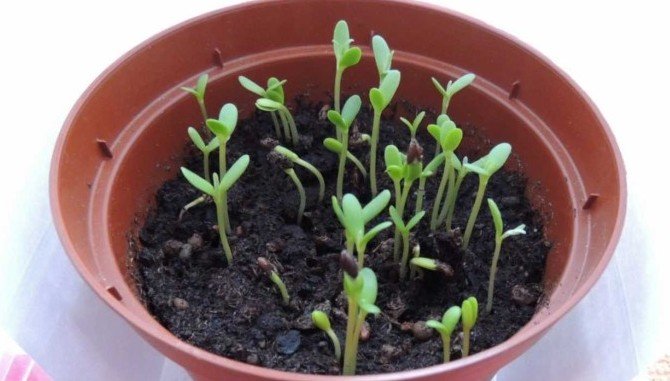
To obtain the mother plant is used exclusively for growth.
If it is decided to propagate this plant by layering, then you need to choose those that are located closer to the ground. In the spring they are tilted to the ground, placed in a prepared groove and lightly sprinkled. And a year later, that is, next spring, the shoots released by the cuttings will be cut off and transplanted to a permanent place.
The most difficult way to breed sea buckthorn will be growing seedlings of their seeds. Despite the fact that it is troublesome, the result will definitely please. From the seeds obtained strong and high-yielding plants. The only negative - small fruits.
Nowadays, sea buckthorn as an ornamental shrub is widely used in landscape design. In the case of even its young shoots. It is used to prevent soil erosion and consolidate the soil of ravines and river banks.
Video about the features and care for sea buckthorn
Densely planted bushes of any of its varieties form a gorgeous hedge, and its neat trees planted in front of the house or behind the fence can serve as an exquisite decorative element of the infield.
Properly planted sea buckthorn will not only decorate the garden, but will also become its own source of vitamins, which are found in large quantities in its sweet and sour fruits.








